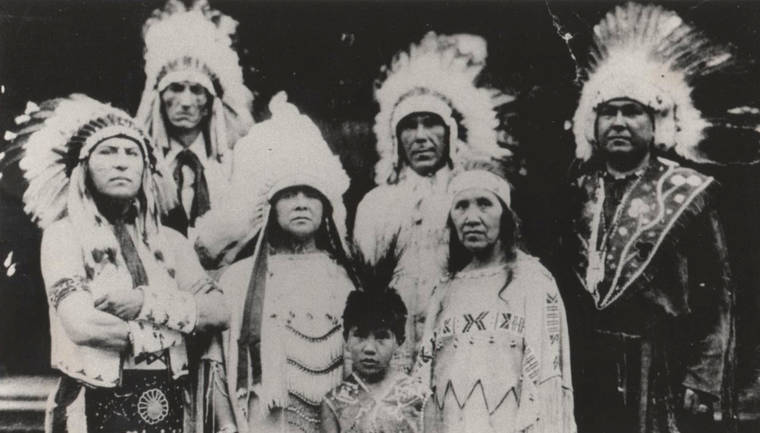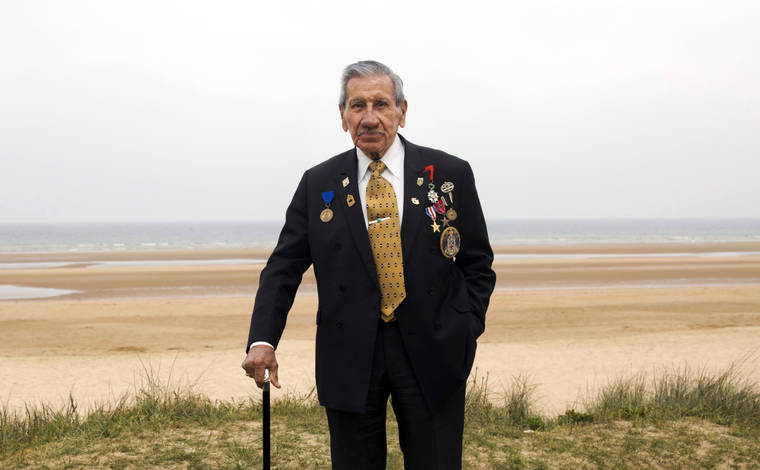ON OMAHA BEACH, France — All at once, Charles Shay tried to stanch the bleeding from a ripped-open stomach, dull the pain with morphine and soothe the mind of a dying fellow American army medic. It was a tall order for a 19-year-old who had just set foot on the European mainland for the first time.
But nothing could have prepared him for what happened on June 6, 1944, on five cold, forbidding beaches in northern France. It was D-Day, one of the most significant 24-hour periods of the 20th century, the horrifying tipping point in World War II that defined the future of Europe.
That morning, Shay could not yet fathom what the event would ultimately mean. He was more concerned with the bleeding soldiers, body parts and corpses strewn around him, and the machine-gun fire and shells that filled the air.
“You have to realize my vision of the beach was very small. I could only experience what I could see,” he told The Associated Press, speaking from the now-glimmering Omaha Beach, where he landed 75 years ago.
International leaders will gather again this week to honor the dwindling number of D-Day veterans. Shay, now 94, plans to be among the crowd Thursday to welcome U.S. President Donald Trump to France as he pays homage to 9,388 dead Americans, most of whom lost their lives on D-Day or in the aftermath of the Normandy offensive.
Omaha and adjacent Utah Beach were America’s to take, but similar acts of sacrifice and heroism happened on three other beachheads to the east where Britain and Canadian troops sought to break Hitler’s stranglehold on the continent. In all, the invasion covered 80 kilometers (50 miles) of French shoreline.
Shay survived, but he did not talk about the experience for well over half a century.
“So many dead. So many young men, young boys, killed on the spot,” he said. “It was difficult to see and absorb.”
A Penobscot native American from Indian Island, Maine, Shay was barely 5 when the Great Depression hit. Across the ocean, Germany also faced economic misery that, together with lingering bitterness over its defeat in World War I, paved the way for Adolf Hitler’s rise.
When containment failed, war in Europe erupted in 1939, and Hitler’s Nazis swarmed over much of the continent. They took Paris and were quickly at the Normandy coastline. Britain remained out of reach.
The United States, which had slumbered into isolationism after its victory in World War I, entered World War II after the Japanese attacked Pearl Harbor on Dec. 7, 1941. Germany declared war on the U.S. in support of its ally.
Shay was trained to be a machinist but could not get a job because he was expected to be drafted into the Army.
So before he knew what life was really about, Shay found himself in a hammock in the hold of the RMS Queen Elizabeth. He was sailing from New York to England, his final destination unknown.
“I never had a sense of fear because I didn’t know what I was getting in to,” Shay said.
The Germans knew an invasion was coming but had no idea when or where, and the most likely options were 400 kilometers (250 miles) apart. Hitler prepared an Atlantic Wall of defenses.
By early June, it was time for Gen. Dwight D. Eisenhower to distribute the orders that he had honed for months.
“The eyes of the world are upon you,” he told his men. “You will bring about the destruction of the German war machine, the elimination of Nazi tyranny.” The death toll was sure to be enormous.
On the two American beachheads, the United States suffered 2,501 killed in action on June 6, 1944. In all, an estimated 4,414 men died on that single day, according to the latest figures.
Few soldiers in the first wave fully realized the risks.
That night before D-Day, the men of Fox Company, 2nd Battalion, 16th Infantry Regiment of the 1st Infantry Division, aka the Big Red One, had more immediate problems — sea sickness, finger-numbing cold and a dangerous descent into landing crafts using rope nets slung over the side of transports that were rolling in heavy seas.
Then they approached the beach.
“I wasn’t too worried about it — until the ramps went down,” Shay recalled.
He landed in water up to his chest. Many soldiers who were overloaded with equipment “sank immediately and a lot of men drowned,” he said.
Those who stayed afloat had to face withering German gunfire. Many of the men standing in front “were hit immediately,” he said.
Once on dry land, he sought cover behind the “high portions” of the beach and started treating the wounded.
At some point, he looked back to the ocean and saw many wounded men lying on the beach as the tide was rising. Without help, they would drown.
So he returned to the water, even though Germans were still shooting, and started pulling men — he doesn’t know how many — above the tide. Many of the soldiers were much bigger and heavier than he was.
“In such a situation, the adrenaline starts to flow,” Shay said. “It gives you strength that you did not know that you had.” He received the Silver Star for his bravery.
When the shooting on the beach slowed, he found fellow F Company medic Edward Morozewicz, who had “an open stomach.” Shay administered morphine and applied bandages. It was to no avail.
“I stayed with him until he died. I tried to converse with him a little bit. I tried to comfort him,” he said.
He left the bloodied beach late that afternoon, completely separated from his company, which had lost all officers and many non-commissioned officers.
Wandering around in a daze of fatigue, he fell asleep in a field. When he awoke in the morning, he was “surrounded by dead people — American and German.”
All these decades later, he is back at the same shores, walking across the immaculate lawns covered with white gravestones and pondering the sacrifice.
“Oh, yes. Definitely it was worth it,” he said. “It was a rogue regime that was trying to take over the world, and the people had to be stopped.”
———
Associated Press photographer Virginia Mayo and video journalist Mark Carlson contributed to this report.
———
Follow all the AP’s coverage of D-Day at https://apnews.com/WorldWarII



